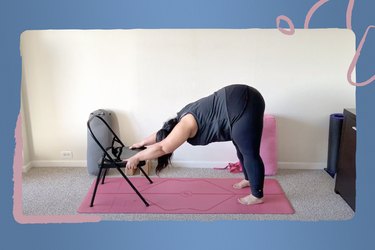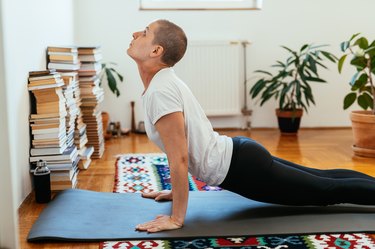

If you have peripheral neuropathy, consider treating your body to a regular yoga practice.
A form of nerve damage that causes tingling, numbness, sensitivity to touch and pain in the hands and feet, peripheral neuropathy most commonly develops as a complication of diabetes, but it can also result from autoimmune diseases, infections and various genetic conditions, according to the Mayo Clinic.
Video of the Day
Fortunately, whatever the cause, yoga can help you feel and move better with peripheral neuropathy, according to a April 2019 review in the Annals of Neurosciences. And doctors are increasingly finding that yoga and gentle movement practices are a pivotal part of managing neuropathy.
Read on to learn about yoga for peripheral neuropathy, the best poses to get started and how they may be able to help ease symptoms — and even discourage progression.
Warning
Talk to your doctor or healthcare professional before beginning a new exercise routine.
The 4 Best Yoga Poses for Peripheral Neuropathy
The severity of neuropathy determines the style and intensity of yoga that's best for you to practice.
Each person is individual and anyone who experience balance issues, lack of mobility or chronic pain may feel uncomfortable doing certain poses, explains Evan Soroka, a certified yoga therapist and the author of Yoga Therapy for Diabetes.
That's why she recommends a Hatha yoga practice that is restorative and focuses on gently connecting you with your body, increasing blood flow and calming your nervous system.
Get started with these four yoga poses for peripheral neuropathy. Do them on their own or practice them in order for a full yoga flow. You can start by doing these once or twice a week, adding on more days if it feels good for you.
Move 1: Calf/Hamstring Stretch
- Lie flat on the ground with your right knee bent, foot on the floor.
- Hook a resistance band or yoga strap around the balls of your left foot.
- Raise your left foot toward the ceiling, keeping a slight bend in your knee.
- Point your toes toward the ceiling and hold here for up to a minute, taking deep breaths.
- Then, flex your toes to point towards your body, heel pressing up toward the ceiling. Hold for several deep breaths.
- Alternate for 8 reps total and then switch legs.
Tip
Using a soft yoga strap, or even wearing socks or shoes, when performing this stretch can help keep your feet safe and comfortable.
Move 2: Seated Cat-Cow
- Sit on the edge of a chair with your feet planted on the ground.
- On a five-second exhale, press your hands out in front of you at shoulder height.
- Slowly allow your head to fall between your hands.
- Inhale for five seconds and pull your hands toward your body, drawing your elbows into your ribs at a 90-degree angle.
- As you inhale, bring your head back up.
- Repeat this motion for 8 rounds.
Tip
Feel free to keep your hands on the seat of the chair to help with balance.
Move 3: Chair Tadasana
- Stand tall behind a chair with your hands on the top of the seat for balance. Keep a slight bend in your knees.
- On an inhale, raise your heels off the ground and rise up onto the balls of your feet.
- Exhale and lower your heels back to the ground and lift the soles of your feet toward the ceiling.
- Go for 8 rounds total.
Tip
Focus on raising your heels, then toes, as far as feels comfortable for you. Don't push through any discomfort.
Move 4: Leg-Supported Savasana
- Lie on the floor with a pillow or blanket under your head.
- Raise your feet onto a chair, allowing your knees to rest on the seat.
- Take a deep inhale in your belly for 3 to 5 seconds.
- Exhale for 6 to 8 seconds, hollowing out your stomach.
- Repeat this breath pattern as you relax in this position.
Tip
If you feel any discomfort in your lower back, place a rolled-up towel under the curve in your lumbar spine.
6 Ways Yoga Can Help Peripheral Neuropathy
1. It May Improve Nerve Health
Exercise is a critical part of effective neuropathy treatment, according to The Foundation for Peripheral Neuropathy. Yoga may even directly combat nerve damage, in part, by acting on receptors throughout the nervous system, according to the Annals of Neurosciences study.
2. It Strengthens Muscles
Over time, neuropathy can contribute to muscle loss and weakness. Yoga can be a gentle, low-impact way to strengthen your muscles without aggravating your symptoms.
3. It Increases Balance and Stability
Peripheral neuropathy in the feet can increase the risk of falls and fractures by affecting the nerves that help you stay balanced on your feet.
That's where yoga comes in. Regularly practicing yoga can help improve balance and stability, according to Soroka. Yoga won't necessarily eliminate risks right away, but can be like a long-term strategy to help build confidence in your movements and reduce
4. It Improves Sleep
Many people living with peripheral neuropathy experience trouble sleeping for multiple reasons including stress, muscular pain or muscle twitching, among others. This is another area yoga may be able to offer a little relief, according to Soroka.
By pairing stretching and intentional breathing, yoga can help relax your body and mind, Soroka says. Over time, this practice can help reduce the chronic pain and stress that may be harming your sleep or causing sleep disruption.
5. It Builds the Mind-Body Connection
The body-mind connection acquired through yoga can also give you a better sense of body awareness.
Yoga can help you develop a better feel for which specific motions are helpful and which are aggravating to your body. Off the mat, this can give you an idea of which tasks or activities you feel comfortable pushing through and which you may want to skip.
6. It Reduces Stress
A regular yoga practice can help you learn to better handle the stress and challenge of living with peripheral neuropathy, according to Soroka.
Peripheral neuropathy can't be cured, but meditative practices can help you learn to manage your stress because you learn to be more mindful and accepting in the present moment. When you learn how to breathe and be present on the mat, you can more easily shift into a pattern of acceptance off the mat.
How to Practice Yoga for Peripheral Neuropathy
Even as little as two weekly sessions of yoga for nerve damage can make a pretty significant benefit for those experiencing symptoms, according to a 2018 study published in the International Journal of Yoga Therapy. In the study, researchers had people with neuropathy do two weekly yoga sessions. After just two month, the yoga practitioners experienced improved body function, stress management and sleep.
All that's to say that, when it comes to yoga for neuropathy, it's all about consistency. Start small, prioritizing regular movement over super-long sessions. Even just 10 minutes a day of breathing and stretching can make a meaningful difference, according to Soroka.
During each session, pay attention to how you feel in your body and modify any poses as needed to best fit your body. The goal is that you feel better not just after your yoga poses, but during them as well.
Is this an emergency? If you are experiencing serious medical symptoms, please see the National Library of Medicine’s list of signs you need emergency medical attention or call 911.


